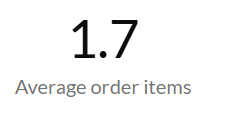Average Order Items Metric
Intended Audience:
Business User
Author:
Movyn John
Changed on:
13 Nov 2025
Overview
Learn about the Average Order Items Metric in Fluent Analytics
Key points
- Higher items per order generally improve profitability through shared shipping costs
- May be influenced by promotional strategies and seasonal buying patterns
- Bundle deals and sets can artificially inflate this metric
What it measures
Average number of items per order created in the selected time period.

When to use this metric
- Monitor cross-selling and upselling effectiveness
- Assess shopping cart optimization strategies
- Plan picking and packing operations
- Evaluate product bundling and recommendation success
How to interpret
- Good performance: Increasing items per order indicates successful cross-selling
- Potential issues: Declining items per order may suggest poor product recommendations
- Benchmark guidance: Varies significantly by industry; track trends more than absolute values
Technical details
Formula:
SUM(order.items.quantity) / COUNT(orders) within the selected time period
Configuration:
- None
Reference Parameters:
`order.created_date`: Filters the metric to orders created within the selected time period`retailer.ref`: Filters the metric to orders from the selected retailer`order.type`: Filters the metric to orders of specific order types (e.g., home delivery, click-and-collect)
